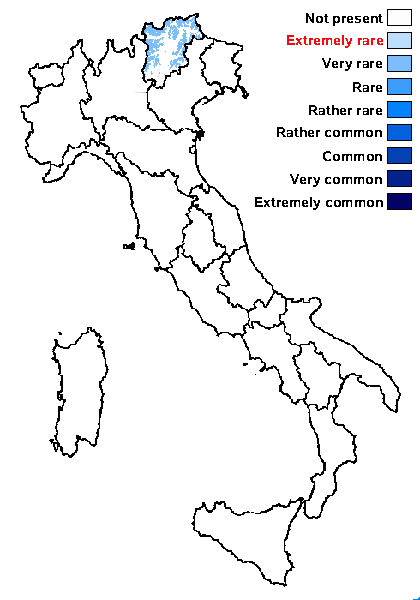Sagedia nunatakkorum (Poelt) S.Y. Kondr.
in Kondratyuk & al., Acta Bot. Hung. 58, 3-4: 383, 2016.. Basionym: Lecanora nunatakkorum Poelt - Mitt. bot. Statssamml. München, 8: 325, 1953.
Synonyms: Aspicilia mastrucata (Wahlenb.) Th. Fr. f. pseudoradiata Arnold; Aspicilia nunatakkorum (Poelt) Poelt ex Hafellner & Türk
Distribution: N - TAA (Dalla Torre & Sarnthein 1902).
Description: Thallus crustose to subfruticose, well-delimited by a black prothallus, dark grey with brown patches, areolate, the areoles giving rise to elongate, simple or irregularly branched 0.2-0.3 mm thick, up to 2 mm tall, isidia-like papillae with an often darker or white-floccose apex. Cortex paraplectenchymatous, 25-30 µm thick; medulla white, paraplectenchymatous, devoid of crystals, I-. Apothecia rare, sparse, solitary, lecanorine-aspicilioid, sessile to shortly stalked, up to 1 mm across, with a black, epruinose, flat disc and a rather thick, raised, grey-black thalline margin. Proper exciple well-developed, of parallel hyphae, extending below the hymenium; epithecium olive-green; hymenium colourless, c, 130 µm high, I+ yellowish; paraphyses coherent, branched in upper part, 1.5-2 µm thick, submoniliform in upper part, the apical cells up to 4 µm wide; hypothecium colourless. Asci 8-spored, the thin outer coat K/I+ blue, the wall and apical dome K/I-. Ascospores 1-celled, hyaline, ellipsoid, 22-27 x 15-18 µm. Pycnidia unknown. Photobiont chlorococcoid. Spot tests: thallus partly K-, partly reacting K+ red (in the brown parts), C-, KC-, P- or P+ yellow (in the brown parts). Chemistry: unknown, probably with norstictic acid.
Note: on exposed siliceous rocks at high altitudes; reported from the Eastern Alps (Austria) where it is not uncommon in the nival belt; probably overlooked elsewhere in the Alps, being often sterile.
Growth form: Crustose
Substrata: rocks
Photobiont: green algae other than Trentepohlia
Reproductive strategy: mainly asexual, by isidia, or isidia-like structures (e.g. schizidia)
Commonnes-rarity: (info)
Alpine belt: very rare
Subalpine belt: very rare
Oromediterranean belt: absent
Montane belt: absent
Submediterranean belt: absent
Padanian area: absent
Humid submediterranean belt: absent
Humid mediterranean belt: absent
Dry mediterranean belt: absent

Predictive model
Growth form: Crustose
Substrata: rocks
Photobiont: green algae other than Trentepohlia
Reproductive strategy: mainly asexual, by isidia, or isidia-like structures (e.g. schizidia)
Commonnes-rarity: (info)
Alpine belt: very rare
Subalpine belt: very rare
Oromediterranean belt: absent
Montane belt: absent
Submediterranean belt: absent
Padanian area: absent
Humid submediterranean belt: absent
Humid mediterranean belt: absent
Dry mediterranean belt: absent

Predictive model
 Index Fungorum
Index Fungorum
 GBIF
GBIF

